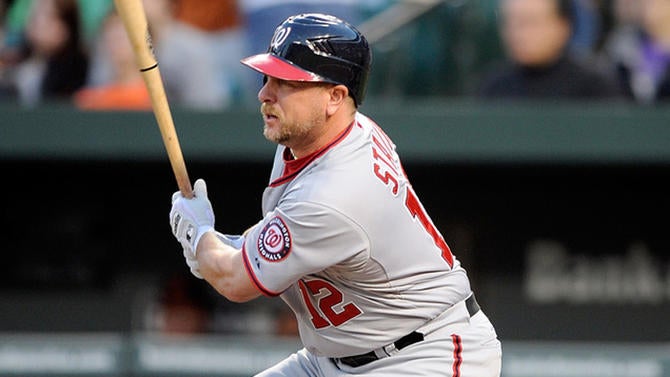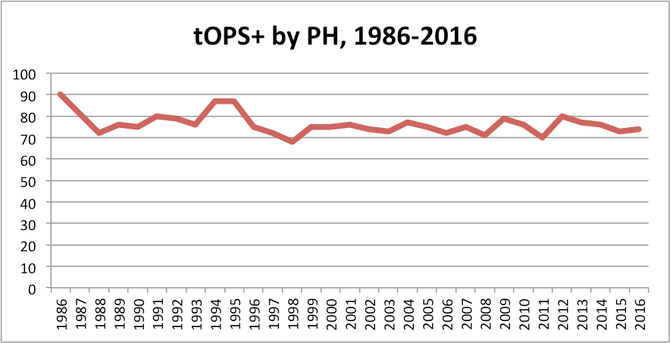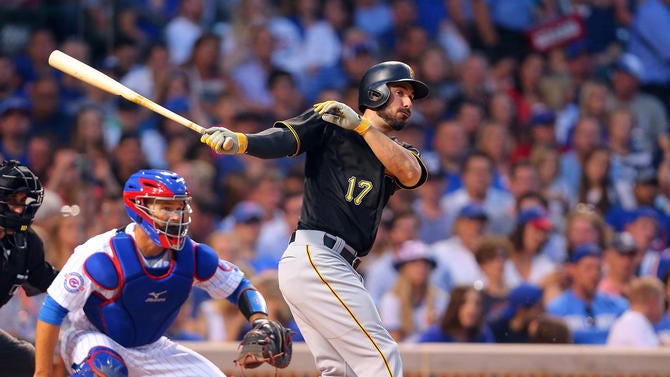When the Pittsburgh Pirates signed Matt Joyce to a minor league contract in February, they were buying a penny stock.
Once a productive regular and 2011 All-Star for the Tampa Bay Rays, Joyce had nearly whiffed his way out of baseball last season, hitting a woeful .174/.272/.291. So when the Buccos took a flyer on him on the eve of spring training, they were guaranteeing nothing more than a minor league contract, with a chance to make $1 million if he made the big league roster...still a rock-bottom salary by today's standards.
With Starling Marte, Andrew McCutchen, and Gregory Polanco -- arguably baseball's best outfield -- ahead of him on the depth chart, Joyce would likely have to prove himself by performing one of baseball's toughest tasks, one that's become a lost art: Come into a game cold, and pound the baseball. Armed with a revamped swing, Joyce has thrived in that role. In 213 times at the plate, the lefty-swinging part-timer is hitting a terrific .264/.399/.529. But his numbers truly explode as a pinch-hitter: In 62 plate appearances, he's batting an incredible .277/.452/.553 -- topping even Mike Trout's season line.
Thanks largely to bloated pitching staffs, Joyce looks like an outlier, a rare ace pinch-hitter who's crushing balls off the bench, at a time when that role looks destined to go the way of the Dodo bird.

In the days of nine-, 10-, and even 11-man pitching staffs, many teams made finding a big bat (or three) off the bench a high priority. If you remember Manny Mota and Wallace Johnson, Lenny Harris and Matt Stairs, you remember professional hitters -- players who didn't run, field, or throw all that well, but made up for it by coming through with huge hits in the pinch. Today, that's become a low priority for most clubs.
"Eight-man bullpens are part of it," said one National League executive, noting the resulting lack of bench spots that ensure when NL clubs with eight-man pens only carry four reserves, AL teams only three. "Teams [also] want guys they can option to keep flexibility, which means sometimes young benches. Also sometimes the focus is on the nine guys in the field. For whatever reason, teams obsess over the starters and don't realize the importance of depth/replacements. It also might be that salaries have risen so much that no one wants to spend on [that kind of hitter]."
To measure how pinch-hitters have progressed (or regressed) over the years, we turn to one of the Internet's greatest gems, Baseball-Reference.com. The site uses a metric called tOPS+ to measure how all players at a certain position fared offensively compared to league-average results for all positions. A score of 100 is exactly average, 90 is 10 percent worse than average, and so on. So if pinch-hitters register a tOPS+ score of 80, that means they're performing 20 percent than hitters as a whole in that particular season.
Since pinch-hitters are usually riding the pine instead of cracking the starting lineup for a good reason, scores below 100 make perfect sense. Still, if we look at the numbers going back 30 years, we can spot a downtrend.

That 1986 season was right in the sweet spot for our pal Wallace Johnson. A nine-year major league veteran, Johnson nabbed just 569 at-bats in his entire career. A jarring 300 of those (53 percent) came as a pinch-hitter. In '86, Johnson did see a little more playing time than usual as a starter. But he still excelled as a pinch-hitter, batting a robust .297/.316/.459 in an era that was friendlier to pitchers than it is today.
As productive as Joyce has been this season off the bench, he's more of a surplus outfielder who gets a bunch of looks in pinch-hitting moments than a true Wallace Johnson; 29 percent of his plate appearances have come in the pinch. While that number falls well short of the specialists who found employment a generation ago, it still dwarfs the rest of the league this year. No player with anywhere near Joyce's total plate appearance number (or level of productivity) has seen such a high percentage of his times at bat come as a PH.

Joyce isn't the only Pirates veteran reserve doing big things this year on the cheap. Pittsburgh signed now-33-year-old cornerman David Freese to a one-year, $3 million deal last offseason. In 15 plate appearances as a pinch-hitter this season, the veteran right-handed batter is hitting a cool .308/.400/.462. That's a tiny sample size of course. But it's consistent with Freese's other work in reserve. Track his entire career, and Freese has batted .275/.383/.412 as a pinch-hitter. And when subbing into games this year either as a pinch-hitter, injury replacement, or late-inning pick-me-up, Freese has slugged a cool .462. Overall, Freese has posted his best offensive numbers since 2012, filled in regularly at both third and first base, and played plus defense in the Pirates' intricate, analytically-oriented system. On Monday, the Pirates rewarded Freese with a two-year, $11 million contract extension.
The third productive member of the taxi squad has been Sean Rodriguez. Another former Ray and Angel, Rodriguez has actually struggled as a pinch-hitter, and during games that saw him enter as a sub. But he's also played every position except catcher, and hit very well overall, checking in at .252/.338/.500. Not bad for a one-year, $2.5 million investment.
Injuries and unexpected struggles for multiple key players might've rendered the efforts of Joyce, Freese, and Rodriguez largely moot, as the Pirates sit on the outer reaches of the National League playoff race. Still, the Bucs would be significantly worse off without the bench crew's efforts.
A few legitimate contenders have likewise sought out depth, and shown a willingness to pay for it. The big-revenue Cubs and Dodgers both made depth a key goal dating all the way back to spring training. Today, they're both first-place teams, despite dealing with some key injuries this season -- the rotation-ravaged Dodgers doubly so.
Still, with as few as three or four bench spots to work with; a backup catcher and a utility infielder pretty much a must; and teams recognizing the importance of defense when filling out that final one or two slots with fly-chasing outfielders, teams simply don't feel able to roster the 30-something offensive specialist who can turn a game with one swing of the bat. That means we might find a very occasional Matt Joyce. But no Wallace Johnsons, or even Matt Stairses.
And that's a damn shame. Teams have developed so many high-90s-throwing monsters into intimidating major league relievers, and managers have grown so adept at deploying them, many teams feel they can get by with a rotation of semi-competent arms that don't even make it out of the sixth inning. The superpen strategy deployed by teams like the Royals and Yankees in recent years thus seems impenetrable.
So here's a modest proposal...you can even call it a prediction: The first team willing to shrink the size of its bullpen by even a body or two could free up the roster space needed to counter the army of relievers other teams throw at it, and thrive as a result. Baseball's substitution rules -- which allow managers to pull a pinch-hitter without him even taking a swing but require a pitcher to face at least one batter -- open up even more opportunities to smash that lefty specialist or situational right-hander to smithereens.
Stairs thrived during the height of the high-offense 1990s and 2000s, when we forgave players for a lack of speed and defensive ability if they could hit dingers, and an aging Canadian could extend his career as one of the greatest pinch-hitting terrors in baseball history. Imagine what a team with a six-man bullpen, an aggressive Triple-A pitching shuttle, and that extra roster spot or two could do today. Imagine what could happen with the game on the line and a big bat at the ready to counter 98-mph cheese with a swing-for-the-moon approach.
In April and August, and even more so in October.


















